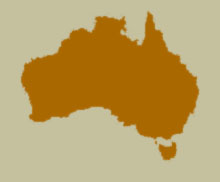Synonyms
Serangium maculigerum Blackburn, 1892: 73.
Serangium bicolor Blackburn, 1895: 255.
Diagnosis
The specimens with elytral spots resemble S. glorious which is smaller, has larger eyes and only a single row of setae along the elytral margins. The uniformly coloured specimens are distinguished from similar species by the male genitalia and the relatively widely separated eyes.
Description
Length 1.5-1.8 mm. Pitch black dorsally with usually a more or less expanded, ill-defined brown or yellowish spot on either elytron; almost black ventrally; head in front and femora brown, antennae, mouth parts, tibiae and tarsi dirty whitish or yellowish. Winged; body shape hemispherical; pronotal margins with narrow rim, visible from above; elytra with inconspicuous swelling near humeral edge; elytral margins with narrow rim, visible from above in anterior half. Head slightly less shiny than pronotal and elytral surface; head impunctate but surface very weakly rugose, covered in long sparse setae. Pronotum with fine punctures associated with sparse setae. Scutellum elongate, triangular, flat, shiny, glabrous. Elytra impunctate with a few long setae in basal third and two rows of relatively evenly spaced setae along margin. Head with moderately large eyes, separated by 2.7 times eye width; flattened medially. Clypeus flat, long, straight anteriorly. Terminal maxillary palpomere broad, oval, obliquely truncate apically, terminal labial palpomere narrow and aciculate. Antenna 9-segmented, scape expanded apically, club elongate, inner margin concave, apex angular. Prosternum mat, surface weakly furrowed, sparsely setose; mesosternum shiny, impunctate; metasternum shiny, impunctate and glabrous. Elytral epipleuron yellowish, broad, flat and perpendicular to elytron in anterior half, with some long setae, narrowing to a mere rim in apical half. Anterior margin of profemur strongly angled in apical third. Tarsus 4-segmented. Abdomen: ventrite 1 large, shiny and glabrous, ventrites 2-5 small, transversely, finely furrowed, glabrous. Last ventrite not grooved laterally.
Male
Male genitalia as figured.
Female
Externally identical to male.
Variation
The typical form has an orange to orange red spot on each elytron but often the spot is not clearly visible except when the specimen is submerged in water; sometimes the spot is entirely absent.
 Distribution and Biology
Distribution and Biology
This species is widely spread throughout Australia and has recently been found in New Zealand.
Species References
Blackburn, T. 1892. Further notes on Australian Coleoptera, with descriptions of new genera and species. XI. Transactions of the Royal Society of South Australia, 15: 20-73.
Blackburn, T. 1895. Further notes on Australian Coleoptera, with descriptions of new genera and species. XVIII. Transactions of the Royal Society of South Australia, 19: 201-258.
Slipinski, A. and Burckhardt, D. 2006. Revision of the Australian Coccinellidae (Coccinellidae). Part 5. Tribe Serangiini. Annales Zoologici (Warszawa), 56(1): 37-58.
[ Top ]
